Vijay Korthikanti
Nemotron-H: A Family of Accurate and Efficient Hybrid Mamba-Transformer Models
Apr 10, 2025Abstract:As inference-time scaling becomes critical for enhanced reasoning capabilities, it is increasingly becoming important to build models that are efficient to infer. We introduce Nemotron-H, a family of 8B and 56B/47B hybrid Mamba-Transformer models designed to reduce inference cost for a given accuracy level. To achieve this goal, we replace the majority of self-attention layers in the common Transformer model architecture with Mamba layers that perform constant computation and require constant memory per generated token. We show that Nemotron-H models offer either better or on-par accuracy compared to other similarly-sized state-of-the-art open-sourced Transformer models (e.g., Qwen-2.5-7B/72B and Llama-3.1-8B/70B), while being up to 3$\times$ faster at inference. To further increase inference speed and reduce the memory required at inference time, we created Nemotron-H-47B-Base from the 56B model using a new compression via pruning and distillation technique called MiniPuzzle. Nemotron-H-47B-Base achieves similar accuracy to the 56B model, but is 20% faster to infer. In addition, we introduce an FP8-based training recipe and show that it can achieve on par results with BF16-based training. This recipe is used to train the 56B model. All Nemotron-H models will be released, with support in Hugging Face, NeMo, and Megatron-LM.
Upcycling Large Language Models into Mixture of Experts
Oct 10, 2024



Abstract:Upcycling pre-trained dense language models into sparse mixture-of-experts (MoE) models is an efficient approach to increase the model capacity of already trained models. However, optimal techniques for upcycling at scale remain unclear. In this work, we conduct an extensive study of upcycling methods and hyperparameters for billion-parameter scale language models. We propose a novel "virtual group" initialization scheme and weight scaling approach to enable upcycling into fine-grained MoE architectures. Through ablations, we find that upcycling outperforms continued dense model training. In addition, we show that softmax-then-topK expert routing improves over topK-then-softmax approach and higher granularity MoEs can help improve accuracy. Finally, we upcycled Nemotron-4 15B on 1T tokens and compared it to a continuously trained version of the same model on the same 1T tokens: the continuous trained model achieved 65.3% MMLU, whereas the upcycled model achieved 67.6%. Our results offer insights and best practices to effectively leverage upcycling for building MoE language models.
An Empirical Study of Mamba-based Language Models
Jun 12, 2024



Abstract:Selective state-space models (SSMs) like Mamba overcome some of the shortcomings of Transformers, such as quadratic computational complexity with sequence length and large inference-time memory requirements from the key-value cache. Moreover, recent studies have shown that SSMs can match or exceed the language modeling capabilities of Transformers, making them an attractive alternative. In a controlled setting (e.g., same data), however, studies so far have only presented small scale experiments comparing SSMs to Transformers. To understand the strengths and weaknesses of these architectures at larger scales, we present a direct comparison between 8B-parameter Mamba, Mamba-2, and Transformer models trained on the same datasets of up to 3.5T tokens. We also compare these models to a hybrid architecture consisting of 43% Mamba-2, 7% attention, and 50% MLP layers (Mamba-2-Hybrid). Using a diverse set of tasks, we answer the question of whether Mamba models can match Transformers at larger training budgets. Our results show that while pure SSMs match or exceed Transformers on many tasks, they lag behind Transformers on tasks which require strong copying or in-context learning abilities (e.g., 5-shot MMLU, Phonebook) or long-context reasoning. In contrast, we find that the 8B Mamba-2-Hybrid exceeds the 8B Transformer on all 12 standard tasks we evaluated (+2.65 points on average) and is predicted to be up to 8x faster when generating tokens at inference time. To validate long-context capabilities, we provide additional experiments evaluating variants of the Mamba-2-Hybrid and Transformer extended to support 16K, 32K, and 128K sequences. On an additional 23 long-context tasks, the hybrid model continues to closely match or exceed the Transformer on average. To enable further study, we release the checkpoints as well as the code used to train our models as part of NVIDIA's Megatron-LM project.
Re-ViLM: Retrieval-Augmented Visual Language Model for Zero and Few-Shot Image Captioning
Feb 09, 2023



Abstract:Augmenting pretrained language models (LMs) with a vision encoder (e.g., Flamingo) has obtained state-of-the-art results in image-to-text generation. However, these models store all the knowledge within their parameters, thus often requiring enormous model parameters to model the abundant visual concepts and very rich textual descriptions. Additionally, they are inefficient in incorporating new data, requiring a computational-expensive fine-tuning process. In this work, we introduce a Retrieval-augmented Visual Language Model, Re-ViLM, built upon the Flamingo, that supports retrieving the relevant knowledge from the external database for zero and in-context few-shot image-to-text generations. By storing certain knowledge explicitly in the external database, our approach reduces the number of model parameters and can easily accommodate new data during evaluation by simply updating the database. We also construct an interleaved image and text data that facilitates in-context few-shot learning capabilities. We demonstrate that Re-ViLM significantly boosts performance for image-to-text generation tasks, especially for zero-shot and few-shot generation in out-of-domain settings with 4 times less parameters compared with baseline methods.
Reducing Activation Recomputation in Large Transformer Models
May 10, 2022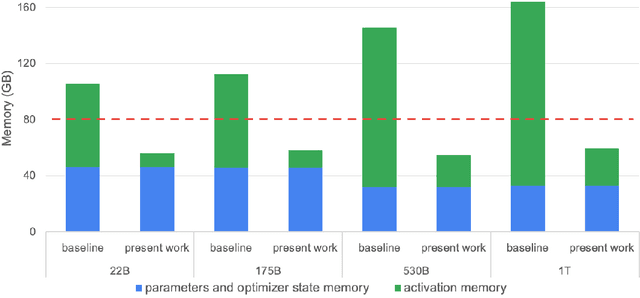


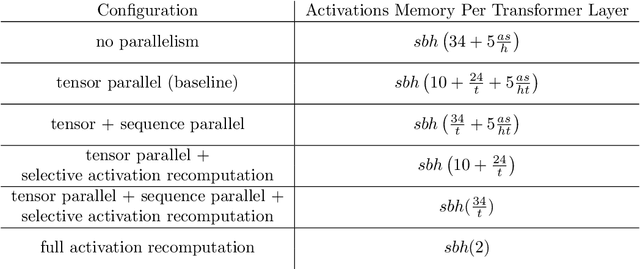
Abstract:Training large transformer models is one of the most important computational challenges of modern AI. In this paper, we show how to significantly accelerate training of large transformer models by reducing activation recomputation. Activation recomputation is commonly used to work around memory capacity constraints. Rather than storing activations for backpropagation, they are traditionally recomputed, which saves memory but adds redundant compute. In this work, we show most of this redundant compute is unnecessary because we can reduce memory consumption sufficiently without it. We present two novel yet very simple techniques: sequence parallelism and selective activation recomputation. In conjunction with tensor parallelism, these techniques almost eliminate the need to recompute activations. We evaluate our approach on language models up to one trillion parameters in scale and show that our method reduces activation memory by 5x, while reducing execution time overhead from activation recomputation by over 90%. For example, when training a 530B parameter GPT-3 style model on 2240 NVIDIA A100 GPUs, we achieve a Model Flops Utilization of 54.2%, which is 29% faster than the 42.1% we achieve using recomputation. Our implementation will be available in both Megatron-LM and NeMo-Megatron.
Using DeepSpeed and Megatron to Train Megatron-Turing NLG 530B, A Large-Scale Generative Language Model
Feb 04, 2022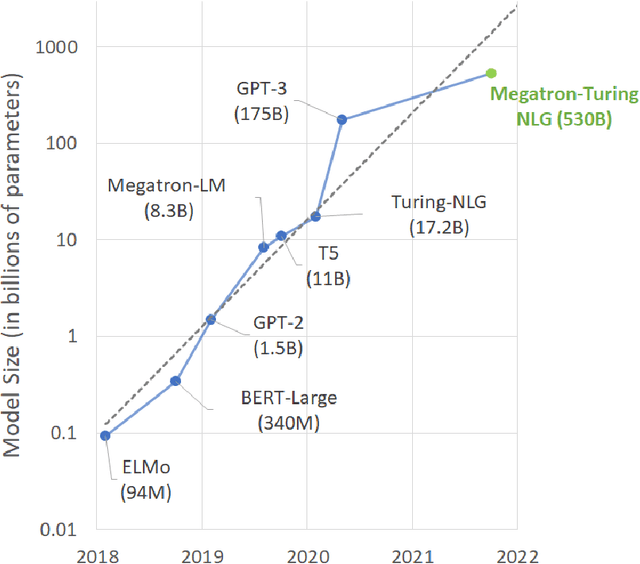
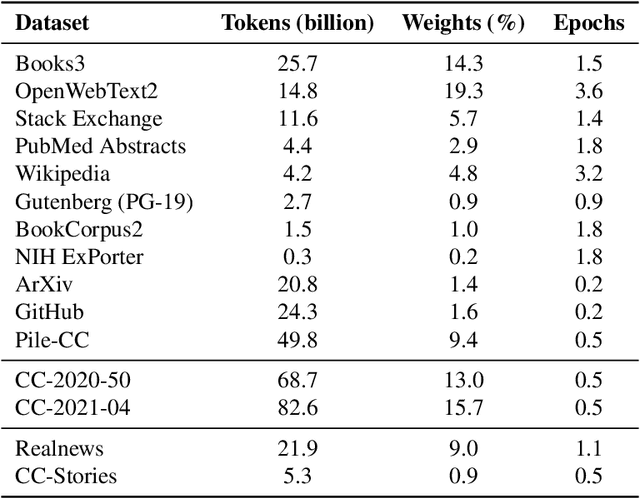
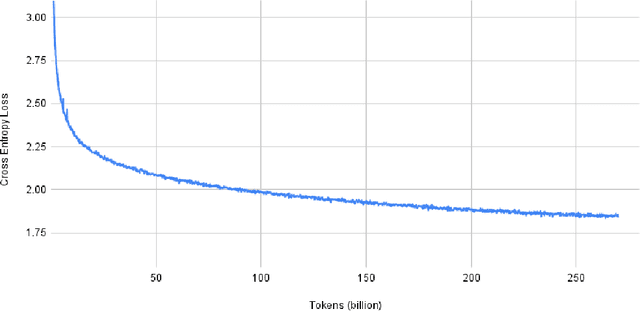
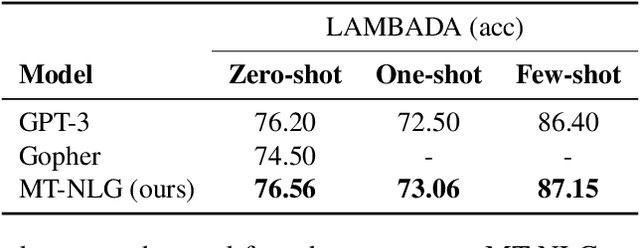
Abstract:Pretrained general-purpose language models can achieve state-of-the-art accuracies in various natural language processing domains by adapting to downstream tasks via zero-shot, few-shot and fine-tuning techniques. Because of their success, the size of these models has increased rapidly, requiring high-performance hardware, software, and algorithmic techniques to enable training such large models. As the result of a joint effort between Microsoft and NVIDIA, we present details on the training of the largest monolithic transformer based language model, Megatron-Turing NLG 530B (MT-NLG), with 530 billion parameters. In this paper, we first focus on the infrastructure as well as the 3D parallelism methodology used to train this model using DeepSpeed and Megatron. Next, we detail the training process, the design of our training corpus, and our data curation techniques, which we believe is a key ingredient to the success of the model. Finally, we discuss various evaluation results, as well as other interesting observations and new properties exhibited by MT-NLG. We demonstrate that MT-NLG achieves superior zero-, one-, and few-shot learning accuracies on several NLP benchmarks and establishes new state-of-the-art results. We believe that our contributions will help further the development of large-scale training infrastructures, large-scale language models, and natural language generations.
Efficient Large-Scale Language Model Training on GPU Clusters
Apr 09, 2021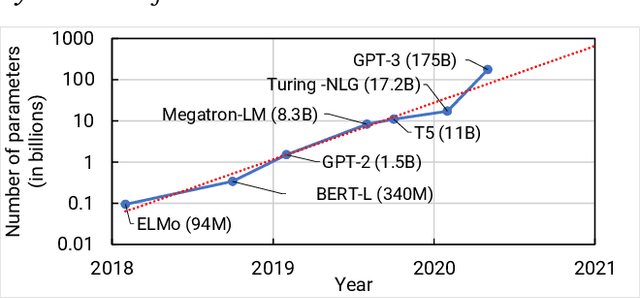
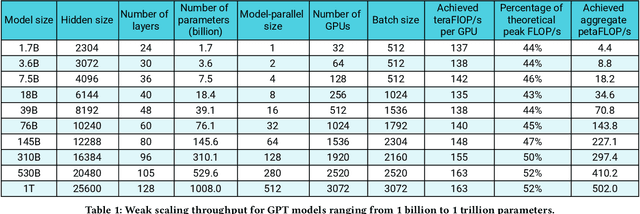


Abstract:Large language models have led to state-of-the-art accuracies across a range of tasks. However, training these large models efficiently is challenging for two reasons: a) GPU memory capacity is limited, making it impossible to fit large models on a single GPU or even on a multi-GPU server; and b) the number of compute operations required to train these models can result in unrealistically long training times. New methods of model parallelism such as tensor and pipeline parallelism have been proposed to address these challenges; unfortunately, naive usage leads to fundamental scaling issues at thousands of GPUs due to various reasons, e.g., expensive cross-node communication or idle periods waiting on other devices. In this work, we show how to compose different types of parallelism methods (tensor, pipeline, and data paralleism) to scale to thousands of GPUs, achieving a two-order-of-magnitude increase in the sizes of models we can efficiently train compared to existing systems. We discuss various implementations of pipeline parallelism and propose a novel schedule that can improve throughput by more than 10% with comparable memory footprint compared to previously-proposed approaches. We quantitatively study the trade-offs between tensor, pipeline, and data parallelism, and provide intuition as to how to configure distributed training of a large model. The composition of these techniques allows us to perform training iterations on a model with 1 trillion parameters at 502 petaFLOP/s on 3072 GPUs with achieved per-GPU throughput of 52% of peak; previous efforts to train similar-sized models achieve much lower throughput (36% of theoretical peak). Our code has been open-sourced at https://github.com/nvidia/megatron-lm.
 Add to Chrome
Add to Chrome Add to Firefox
Add to Firefox Add to Edge
Add to Edge